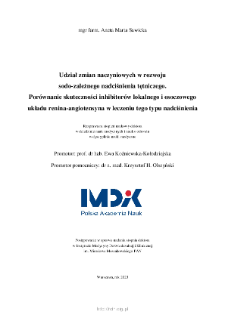
Obiekt
Tytuł: Udział zmian naczyniowych w rozwoju sodo-zależnego nadciśnienia tętniczego. Porównanie skuteczności inhibitorów lokalnego i osoczowego układu renina-angiotensyna w leczeniu tego typu nadciśnienia
Twórca instytucjonalny:
Instytut Medycyny Doświadczalnej i Klinicznej im. Mirosława Mossakowskiego PAN
Współtwórca:
Koźniewska- Kołodziejska, Ewa (Promotor) ; Olszyński, Krzysztof H. (Promotor pomocniczy)
Miejsce wydania:
Uzyskany tytuł:
Stopień studiów:
Dyscyplina :
Instytucja nadająca tytuł:
Instytut Medycyny Doświadczalnej i Klinicznej im. M. Mossakowskiego PAN
Abstrakt:
A high-sodium diet is one of the important risk factors for developing cardiovascular diseases, including high blood pressure and stroke. The mechanisms underlying the increase in blood pressure due to high sodium intake is not well understood. The results of experimental studies of the last decades on the effect of a highsodium diet on the circulatory system have drawn the attention of researchers to the vascular system of renin-angiotensin (RAS). This is one of the tissue systems where Ang I is converted to Ang II locally with a help of serine proteases such as chymase. Additionally, it was shown that an increase in the concentration of sodium ions in the extracellular environment reduces the sensitivity of endothelial cells to mechanical deformation (endothelial stiffening) and reduces the secretion of nitric oxide (NO) in response to shear stress. Based on in vitro studies, an increased concentration of sodium ions are due to damage to the glycocalyx of the endothelium. This leads to endothelial dysfunction which results in reduced NO secretion. The consequence of endothelial stiffening and glycocalyx damage is an increase in vascular resistance and an increase in blood pressure. Studies on the effect of a high-sodium diet and sodium-dependent hypertension on the regulation of resistance blood vessel are fragmentary, and conclusions are often derived from ex vivo studies on cell cultures of cells that are constituents of the vessel wall. It is not known to what extent the changes occurring in the resistance vessels in the course of sodium-dependent hypertension are conditioned by the increased supply of sodium in the diet, and to what extent by hypertension itself. It is also unknown whether and to what extent the renin-angiotensin vascular system is involved in the development or maintenance of sodium-dependent hypertension. Examination of the latter issue seems to be particularly important from the point of view of some problems associated with the treatment of human hypertension with ACE inhibitors. Long-term treatment with drugs from this group loses effectiveness in about 15% of patients. This phenomenon is called 'angiotensin escape' and is characterized by a progressive increase in plasma Ang II levels despite continued treatment. Therefore, it seems reasonable to search for drugs that inhibit the formation of angiotensin II independent of ACE inhibitors. Thus the aim of this project was to test the following hypotheses: 1. A long-term high-sodium diet causes functional changes: I. in peripheral resistance blood vessels, which have a significant impact on the development of sodium-dependent arterial hypertension; II. in the middle cerebral artery, leading to impairment of endothelium-dependent regulation of cerebral circulation; 2. Long-term high-sodium diet adversely affects the intestinal microbiota, leading to excessive production of trimethylamine (TMA) and its oxidized derivative TMAO; 3. The development of sodium-dependent hypertension is associated with the activation of both plasma and local renin-angiotensin system; 4. Chymase inhibitors are more effective than ACE inhibitors as hypotensive therapy in sodium-dependent hypertension. Concluding, the obtained results indicate that high sodium diet, even if it is not accompanied by an increase in plasma sodium ions concentration and hypertension, leads to endothelial dysfunction demonstrated both in peripheral and cerebral resistance arteries. Moreover, a high sodium diet enhances the response to vasoconstrictors of peripheral but not cerebral resistance arteries. Both plasma and tissue renin-angiotensin systems are involved in the development of sodium-dependent hypertension, however, blocking the tissue system seems to be more effective in lowering blood pressure than blocking the blood plasma RAS.
Szczegółowy typ zasobu:
Identyfikator zasobu:
Źródło:
IMDiK PAN, ZS 432 ; kliknij tutaj, żeby przejść
Język:
Język streszczenia:
Prawa:
Licencja Creative Commons Uznanie autorstwa 4.0
Zasady wykorzystania:
Zasób chroniony prawem autorskim. [CC BY 4.0 Międzynarodowe] Korzystanie dozwolone zgodnie z licencją Creative Commons Uznanie autorstwa 4.0, której pełne postanowienia dostępne są pod adresem: ; -
Digitalizacja:
Instytut Medycyny Doświadczalnej i Klinicznej im. M. Mossakowskiego Polskiej Akademii Nauk
Lokalizacja oryginału:
Biblioteka Instytutu Medycyny Doświadczalnej i Klinicznej im. M. Mossakowskiego PAN
Dofinansowane ze środków:
Dostęp:
Kolekcje, do których przypisany jest obiekt:
- Repozytorium Cyfrowe Instytutów Naukowych > Kolekcje Partnerów > Instytut Medycyny Doświadczalnej i Klinicznej PAN > Prace dyplomowe > Prace doktorskie
Data ostatniej modyfikacji:
2 kwi 2024
Data dodania obiektu:
26 mar 2024
Liczba pobrań / odtworzeń:
15
Wszystkie dostępne wersje tego obiektu:
https://www.rcin.org.pl/publication/276499

 INSTYTUT ARCHEOLOGII I ETNOLOGII POLSKIEJ AKADEMII NAUK
INSTYTUT ARCHEOLOGII I ETNOLOGII POLSKIEJ AKADEMII NAUK
 INSTYTUT BADAŃ LITERACKICH POLSKIEJ AKADEMII NAUK
INSTYTUT BADAŃ LITERACKICH POLSKIEJ AKADEMII NAUK
 INSTYTUT BADAWCZY LEŚNICTWA
INSTYTUT BADAWCZY LEŚNICTWA
 INSTYTUT BIOLOGII DOŚWIADCZALNEJ IM. MARCELEGO NENCKIEGO POLSKIEJ AKADEMII NAUK
INSTYTUT BIOLOGII DOŚWIADCZALNEJ IM. MARCELEGO NENCKIEGO POLSKIEJ AKADEMII NAUK
 INSTYTUT BIOLOGII SSAKÓW POLSKIEJ AKADEMII NAUK
INSTYTUT BIOLOGII SSAKÓW POLSKIEJ AKADEMII NAUK
 INSTYTUT CHEMII FIZYCZNEJ PAN
INSTYTUT CHEMII FIZYCZNEJ PAN
 INSTYTUT CHEMII ORGANICZNEJ PAN
INSTYTUT CHEMII ORGANICZNEJ PAN
 INSTYTUT FILOZOFII I SOCJOLOGII PAN
INSTYTUT FILOZOFII I SOCJOLOGII PAN
 INSTYTUT GEOGRAFII I PRZESTRZENNEGO ZAGOSPODAROWANIA PAN
INSTYTUT GEOGRAFII I PRZESTRZENNEGO ZAGOSPODAROWANIA PAN
 INSTYTUT HISTORII im. TADEUSZA MANTEUFFLA POLSKIEJ AKADEMII NAUK
INSTYTUT HISTORII im. TADEUSZA MANTEUFFLA POLSKIEJ AKADEMII NAUK
 INSTYTUT JĘZYKA POLSKIEGO POLSKIEJ AKADEMII NAUK
INSTYTUT JĘZYKA POLSKIEGO POLSKIEJ AKADEMII NAUK
 INSTYTUT MATEMATYCZNY PAN
INSTYTUT MATEMATYCZNY PAN
 INSTYTUT MEDYCYNY DOŚWIADCZALNEJ I KLINICZNEJ IM.MIROSŁAWA MOSSAKOWSKIEGO POLSKIEJ AKADEMII NAUK
INSTYTUT MEDYCYNY DOŚWIADCZALNEJ I KLINICZNEJ IM.MIROSŁAWA MOSSAKOWSKIEGO POLSKIEJ AKADEMII NAUK
 INSTYTUT PODSTAWOWYCH PROBLEMÓW TECHNIKI PAN
INSTYTUT PODSTAWOWYCH PROBLEMÓW TECHNIKI PAN
 INSTYTUT SLAWISTYKI PAN
INSTYTUT SLAWISTYKI PAN
 SIEĆ BADAWCZA ŁUKASIEWICZ - INSTYTUT TECHNOLOGII MATERIAŁÓW ELEKTRONICZNYCH
SIEĆ BADAWCZA ŁUKASIEWICZ - INSTYTUT TECHNOLOGII MATERIAŁÓW ELEKTRONICZNYCH
 MUZEUM I INSTYTUT ZOOLOGII POLSKIEJ AKADEMII NAUK
MUZEUM I INSTYTUT ZOOLOGII POLSKIEJ AKADEMII NAUK
 INSTYTUT BADAŃ SYSTEMOWYCH PAN
INSTYTUT BADAŃ SYSTEMOWYCH PAN
 INSTYTUT BOTANIKI IM. WŁADYSŁAWA SZAFERA POLSKIEJ AKADEMII NAUK
INSTYTUT BOTANIKI IM. WŁADYSŁAWA SZAFERA POLSKIEJ AKADEMII NAUK


































